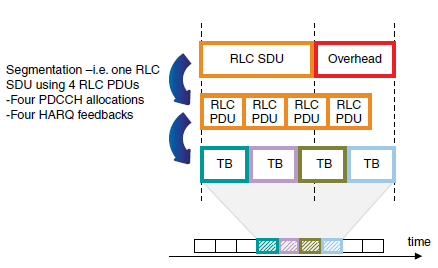The Problem: VoLTE Coverage
Reasons:
- VoLTE deployments have targeted use of high definition voice codes such as AMR 12.65 kbps for improved voice quality, while many 2G/3G voice network designs have been based on lower rate narrow band voice even AMR 5.9 kbps, which can provide larger coverage since fewer bits need to be sent.
- VoLTE has additional IP, PDCP, RLC, and MAC header overhead compared to circuit switched based
voice. This extra IP overhead for VoLTE compared to 2G/3G CS voice again means fewer bits for coding, reducing receiver sensitivity.
Solution:
In order to get good VoLTE coverage, segmentation and TTI bundling is used.
- Segmentation: VoLTE packets are split into smaller parts in order to distribute transmission over several
TTIs. Since the UE output power is limited, it is important to achieve continuous transmission to maximize the transmitted energy.

- TTI bundling is used to minimize overhead, by autonomous retransmission over four consecutive TTIs. This reduces the need for segmentation and also control signaling needed to schedule each transmission. Also, minimum bandwidth allocation could be adopted to enhance the UL coverage.

TTI Bundling is intended particularly for addressing LTE uplink link budget issues and balance the uplink coverage with the downlink coverage footprint.
Conclusion
There’re some advantages for TTI Bundling over Segmentation as below:
- UL resources over multiple TTI’s can be assigned with a single grant (same format as for ordinary HARQ),
that means It decreases the signaling overhead. - Only one HARQ feedback message exists per bundle. requires less retransmissions that means Low control signaling and the vulnerability to NACK to-ACK errors that can lead to data loss.
- RLC & MAC overhead headers in addition to CRC is reduced that means more efficient use of radio resources.
